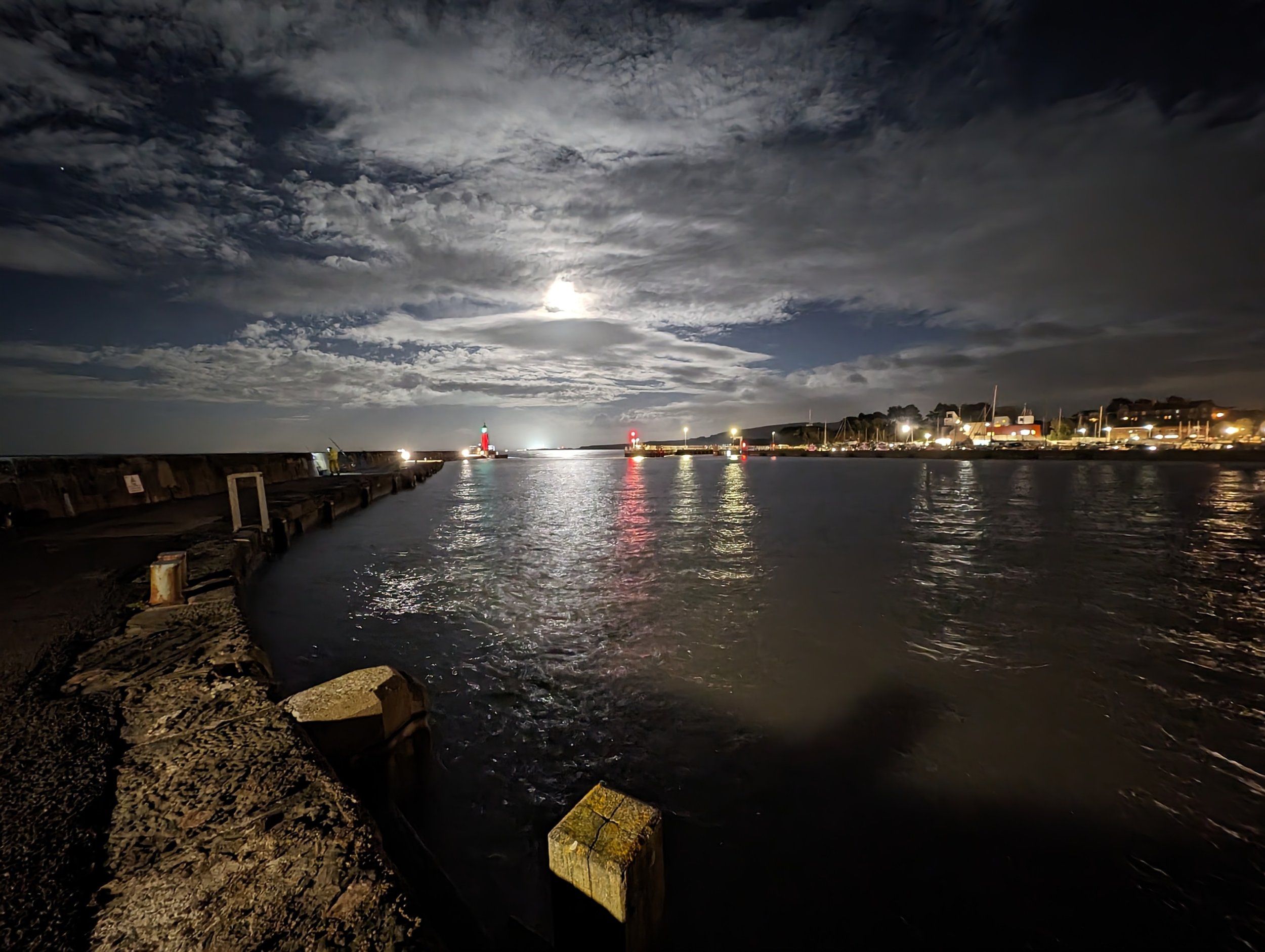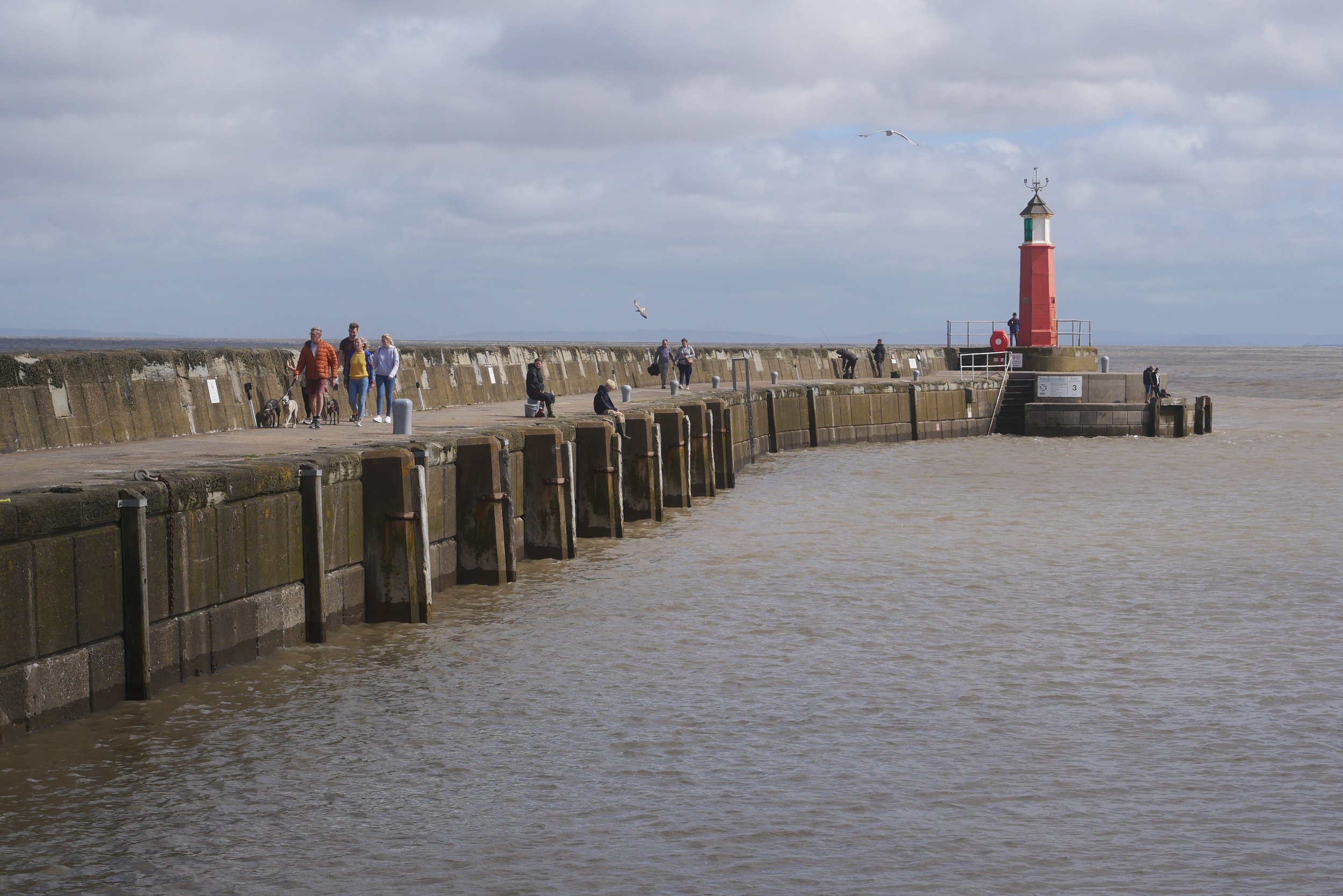Wonders of Watchet
Last night I went down to Watchet to see the high tide - and took my trusty camera-phone with me. The harbour looks amazing when a very high tide comes up the Bristol Channel. It got me thinking about an article I wrote for the Western Morning News 23 years ago - an article which I reproduce here, despite it being very old news.
There is something surprising and unexpected about Watchet. It's hard to say what exactly, but it has about it the tang of salt and the twang of sea-shanty, and even though it's closer to inland Britain than any other West Country port, it has deep ocean in its veins.
It is a town more full of enigmas and idiosyncrasies than any other I know. For instance, it has been sitting on its crumbling Somerset cliffs since before records began, and yet it has the feel of a community that has been scooped up lock-stock-and-barrel from the north of England and deposited on the West Country coast. Nearer to Merseyside than Minehead you might say.
And often, when you go there, the tide has disappeared halfway to Wales so that a first-time visitor could be forgiven for thinking that the sea has forsaken the place altogether. Six hours later, the second highest tidefall in the world has pulled back that same sea so that it is beating at the very doors of the ancient town.
The list of oddities goes on: for instance, many places have a town crier but Watchet goes one further - it has an official swine-herd as well...
It boasts the largest museum collection of flat-bottomed boats anywhere in the world, has one of the smallest commercial radio stations in the country and worships in a church named after a saint who was thanked by locals for his preachings by having his head cut off.
The town is supposed to be run by an ancient organ of local authority known as a Court Leet, but members only meet once a year and only then if a secret recipe rum punch is served to them.
It's famous as being the last home and maybe resting place of Yankee Jack who was the deep water mariner who gave us such shanties and songs as 'A Rovin', 'Rio Grande', 'Shenondoa' and 'The sailor Likes His Bottle O' and many, many more. But though he was born and he died here, no-one knows where John Short (as he was more properly known) is buried.
I could go on and tell you that this is the only place in Europe where men catch prawns with disused bicycle wheels, where men once hunted for eels with dogs, where Daniel Defoe was sufficiently moved by Watchet fossils to write about them; the very place indeed, which inspired the poet Coleridge to pen 'The Ancient Mariner'.
Suffice to say that Watchet is an enigma. It is a place well worth visiting soon before the look and feel of the place changes forever, as it will if half the town has its way and sees the building of a marina which is scheduled to be started this year.
That half the town doesn't want the marina is simply par for the course in a place like Watchet. After all, there can be few communities which would even think of spurning a £5.1 million injection of cash designed to kick-start the local economy.
At the moment the town is awaiting the results of an official enquiry which was held at the end of last year to study the potential closing of the commercial harbour. A closure would require an Act of Parliament, one which will not be contemplated until the results of the enquiry are published at the end of this month.
"We hope it will go through," journalist Tony James told me from his office high above The Esplanade. He is Chairman of the Watchet Boat Owners Association, so you might expect him to be backing the building of a multi-million pound marina where now there is only mud...
"It's not really that," groans Mr James. "I just can't understand what people have got against this development which really is an incredible opportunity for the town. There hasn't been a cargo boat in here since 1993 - things have changed in the shipping industry and, what with insurance and everything, ship-owners are not happy for their vessels to dry out every tide - which at Watchet they have to do.
"The mud in the harbour has now built up to a dangerous level. In the middle it's over 12 feet deep and increasing at a foot a year. This development could be the answer to a lot of problems and it would undoubtedly be popular with the rapidly growing Bristol Channel boating fraternity - bringing all sorts of new business to the town."
It all sounds convincing enough, but many local people are against the development which includes provision for 18 new homes to be built on the East Quay which was once the port's centre of commercial operations.
"More than half the town is against it if you look at the results of a privately commissioned referendum," says fine art dealer Nick Cotton who is a third generation businessman in Watchet with a shop in the main street.
"For a start we don't believe the artist's impressions of how this thing will look. I could almost live with what's been portrayed with boats bobbing about - but we believe the water level won't be much higher than the existing silt level, so the whole look of the thing will be far different from what's being claimed.
"But people are most unhappy with the housing development," according to Mr Cotton, "They'd far rather see an all-weather tourist attraction being built on the East Quay, which is something the town needs much more than a place for a few boats belonging to people who don't even live here."
At the moment Watchet is a town divided and some people grumble privately that things are getting a bit personal. It's a hot potato which is set to run and run. No doubt the big decisions will be reported in the WMN and I'd be better employed here explaining some of those Watchet oddities.
For a start - the industrial, northern look of the place. Well, this was the once the scene of what could be described as an 'iron-rush' when thousands of Welsh miners turned up to help with the iron-ore mines in the nearby Brendon Hills. It was a short-lived affair in the second half of the 1800's, but a special railway was built linking Watchet with the mines and there are still plenty of Williams, Griffiths and Davies left to bear witness to these demographics to this day.
Also to this day the town is somewhat dominated to the south by the huge paper mill which has provided West Somerset with its biggest single source of employment and its only industrial factory for more than a century.
As for the swine-herd, he really is an officer appointed by the Court Leet which meets once a year with few powers left since the good old days when its members ruled the manorial roost, save for the keeping of the secret recipe of a strong rum punch.
The Watchet Boat Museum is genuinely thought to have the largest collection of antique, flat-bottomed boats anywhere in the world, and you can see them in the re-purposed railway shed opposite the station. As for that beheaded saint, he was able to stick his head back on with the help of curative waters still to be found at St Decuman's Well.
In the summer local people still catch prawns by hurling net-filled bicycle wheels over the pier on ropes, but they no longer use terriers for the antediluvian sport of glatting in which congers were hunted in their crannies along the beach.
Coleridge and Defoe really did write about this enigmatic port and now, in the most humble of ways, so have I - in the hopes that you will visit the place and witness its idiosyncrasies for yourself.





















